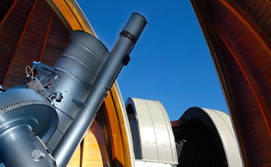A patent has been applied for, and a prototype has already been developed for the Gran Telescopio Canarias. This robotic system will be able to be used in fiber spectrographs located in giant telescopes, where it is essential to optimally take advantage of time.
The field of vision in telescopes today can cover hundreds of objects, and fiber spectrographs permit placing each fiber in the exact position needed, in order to gather in the light from each of the objects of interest to astronomers. The fibers transmit that light to the spectrograph and, in this manner, it’s possible to observe and analyze multiple objects simultaneously. One of the problems with this system is reconfiguring the fibers when the field of vision changes, a process that should be as seamless as possible in order to avoid losing observation time, which is always limited.
 In many current spectrographs the fibers are placed in magnetic buttons, and an arm distributes them to their positions; this process is very time consuming. In contrast, the robotic system developed by the CSIC and the firm AVS, in collaboration with the University of Barcelona, allows changing from one observation map to another in less than 40 seconds. This is independent of the number of fibers, which can number 1,000.
In many current spectrographs the fibers are placed in magnetic buttons, and an arm distributes them to their positions; this process is very time consuming. In contrast, the robotic system developed by the CSIC and the firm AVS, in collaboration with the University of Barcelona, allows changing from one observation map to another in less than 40 seconds. This is independent of the number of fibers, which can number 1,000.
This innovative fiber positioner will bring speed and efficiency to both existing instruments and future projects such as the BigBOSS: an instrument under development at the Lawrence Berkeley National Laboratory (USA), which has already asked the team from the CSIC for the design of the fiber positioner system. The concept, design and functionality of the prototype will be presented at the end of the month in a SPIE conference, an internationally recognized instrument society.